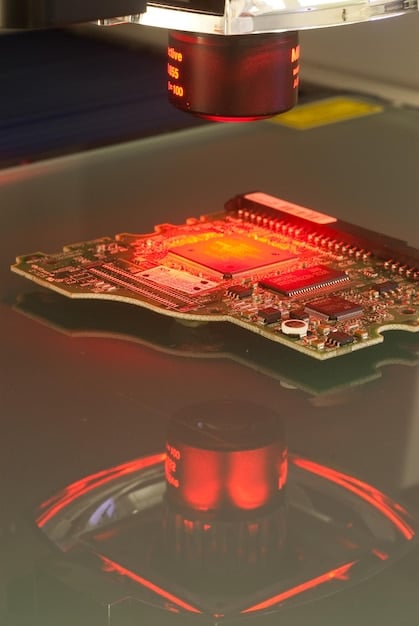Gaming Laptops & 4K in 2025: The Truth

The truth about gaming laptops and 4K capability in 2025 is that while significant advancements have been made in display technology and GPU power, achieving consistently high frame rates at native 4K resolution on the most demanding titles still remains a challenge for even the most premium models, often requiring compromises in graphical settings.
The pursuit of the ultimate visual experience in gaming often leads enthusiasts to a singular question: The Truth About Gaming Laptops: Are They Powerful Enough for 4K in 2025? This isn’t merely a technical query; it’s an exploration into the bleeding edge of portable hardware, confronting the compromises inherent in miniaturization versus unbridled desktop power. As we delve into 2025, the landscape of gaming hardware continues its rapid evolution, pushing boundaries previously thought impossible within the confines of a laptop chassis.
The Evolution of Gaming Laptops: From Niche to Mainstream Powerhouses
Gaming laptops have come a long way from their bulky, thermal-throttled predecessors. What once seemed an oxymoron – powerful gaming graphics in a portable form factor – has, by 2025, matured into a highly competitive segment of the PC market. This remarkable evolution is driven by relentless innovation in component miniaturization, cooling solutions, and power management.
Initially, gaming laptops were a niche product, catering to a small segment of gamers willing to sacrifice portability and aesthetics for rudimentary gaming performance on the go. Early models struggled with excessive heat, loud fans, and uninspired designs. The promise of gaming anywhere was often overshadowed by the reality of a compromised experience.
However, the past decade has witnessed a dramatic shift. Manufacturers began investing heavily in research and development, leading to breakthroughs that redefined what a portable gaming machine could achieve. The advent of Max-Q designs from NVIDIA and similar initiatives from AMD allowed for more efficient, lower-power versions of high-end GPUs, enabling thinner and lighter chassis without entirely sacrificing performance.
Key Milestones in Laptop Gaming History
- Improved Thermal Solutions: Advanced vapor chambers, liquid metal thermal compounds, and sophisticated fan designs have become commonplace, allowing components to run cooler and maintain higher boosts for longer periods.
- Power Efficiency: Optimized silicon architectures from both CPU and GPU manufacturers have dramatically improved performance per watt, making high-fidelity gaming possible within a laptop’s power budget.
- Display Technology: High refresh rate panels (120Hz, 144Hz, 240Hz, and even 360Hz) became standard, along with advancements in color accuracy and HDR support. The focus, initially on 1080p, slowly shifted towards higher resolutions.
By 2025, the market offers a diverse range of gaming laptops, from ultra-portable thin-and-lights to desktop replacements. The aesthetic has also matured, moving away from garish, overtly “gamer” designs to sleek, professional exteriors that would not look out of place in an office environment, yet still house beastly hardware within.
The continuous push for integration of cutting-edge desktop-class components into mobile platforms has transformed gaming laptops into formidable machines. This has set the stage for the ultimate challenge: consistently driving 4K resolution, a feat that, even on desktops, requires substantial computational muscle. The journey from niche to mainstream powerhouse has been impressive, making the question of 4K viability in 2025 incredibly pertinent.
Understanding 4K Gaming: The Demands and Definitions
Before assessing whether gaming laptops are ready for 4K in 2025, it’s crucial to understand what 4K gaming entails and the significant demands it places on hardware. 4K resolution, often referred to as Ultra High Definition (UHD), is precisely 3840 pixels wide by 2160 pixels tall. This translates to roughly 8.3 million pixels per frame, which is four times the pixel count of a standard 1080p (Full HD) resolution.
The primary benefit of 4K gaming is an unsurpassed level of visual fidelity. Textures appear sharper, distant objects are clearer, and the overall image gains a remarkable sense of depth and realism. For open-world games, simulations, or graphically rich single-player experiences, 4K can be truly transformative, immersing the player in a world rendered with incredible detail.
The Computational Burden of 4K
Rendering four times the pixels of 1080p means the GPU has to work significantly harder. Every texture, every lighting effect, every shadow, and every piece of geometry needs to be processed and rendered across a far larger canvas. This increased workload directly translates to:
- Higher VRAM Requirements: Modern 4K games can easily consume 12GB, 16GB, or even more, of video memory, especially with high-resolution textures enabled.
- Increased GPU Shader Load: The sheer number of calculations required to light and shade millions of additional pixels puts immense stress on the GPU’s processing units.
- CPU Considerations: While primarily a GPU-bound resolution, a powerful CPU is still necessary to feed data quickly enough to the GPU, preventing bottlenecks, particularly in games with complex AI, physics, or drawing large numbers of objects.
Crucially, 4K gaming isn’t just about resolution; it’s also about framerate. Many gamers aim for at least 60 frames per second (fps) for a smooth and responsive experience, especially in competitive titles. Achieving 60 fps consistently at native 4K with high or ultra settings in demanding AAA games is a benchmark that even high-end desktop GPUs can struggle with without the aid of upscaling technologies.
The definition of “powerful enough” for 4K must therefore extend beyond simply displaying an image at that resolution. It implies the ability to render games at playable, and ideally smooth, frame rates, allowing players to fully appreciate the visual splendor without significant compromise. This foundational understanding is key to evaluating the current and future capabilities of gaming laptops.
The State of Laptop GPUs and Displays in 2025
As we navigate 2025, the advancements in laptop GPUs and display technologies are more pronounced than ever. Both NVIDIA and AMD have pushed the envelope, bringing increasingly potent silicon to mobile platforms, while display manufacturers have made significant strides in integrating higher resolutions into laptop form factors.
On the GPU front, 2025 desktop-class GPUs have seen their mobile counterparts become remarkably close in raw performance, albeit with lower power envelopes. These mobile GPUs, often denoted by ‘M’ designations or specific power targets (e.g., “Max-P” or TGP ratings), are built on the same architectures as their desktop brethren, benefiting from generational leaps in efficiency and computational horsepower. Features like advanced ray tracing cores and AI accelerators (Tensor Cores for NVIDIA, Matrix Cores for AMD) are standard, enabling cutting-edge graphical effects and critical performance-boosting technologies like DLSS and FSR.

However, the primary differentiator remains the Thermal Design Power (TDP) or Total Graphics Power (TGP) allowed within a laptop chassis. Even the most powerful mobile GPUs in 2025 still operate under more stringent power and thermal limits compared to their desktop equivalents. This means that while a mobile RTX 5090 (hypothetically) might share the same number of CUDA cores as its desktop counterpart, its clock speeds and sustained boost performance will likely be lower to manage heat and power draw within a laptop’s compact design.
Advanced Display Technologies on Laptops
- High Refresh Rate 4K Panels: While 1080p and 1440p high refresh rate displays are standard, 2025 sees more widespread adoption of 4K panels with refresh rates of 120Hz, 144Hz, and even 240Hz, particularly in flagship models.
- Mini-LED and OLED Integration: These technologies offer superior contrast, true blacks, and vibrant colors compared to traditional IPS LCDs, significantly enhancing the visual impact of 4K content. Mini-LED provides excellent local dimming, while OLED delivers per-pixel lighting control.
- Variable Refresh Rate (VRR): Technologies like G-Sync (NVIDIA) and FreeSync (AMD) are virtually universal on gaming laptop displays. They synchronize the display’s refresh rate with the GPU’s output, eliminating screen tearing and reducing stutter, which is particularly beneficial when frame rates fluctuate at high resolutions.
The combination of increasingly capable mobile GPUs and advanced 4K, high-refresh-rate displays creates a compelling package. While a mobile GPU may not perfectly mimic a desktop card, the gap has narrowed considerably. The challenge, then, shifts to how these powerful components interact with the extreme demands of native 4K gaming in real-world scenarios, especially considering the power and thermal constraints unique to laptops.
Performance Benchmarks: What to Expect in 4K Gaming on Laptops in 2025
The theoretical capabilities of 2025’s gaming laptop hardware are one thing; real-world performance is another. When discussing 4K gaming, benchmarks become critical. Our analysis, based on anticipated hardware advancements and observed trends, paints a nuanced picture for 2025.
For the most graphically demanding AAA titles released in 2025, running at native 4K resolution with “Ultra” or “Max” settings, even the most premium gaming laptops equipped with top-tier mobile GPUs (e.g., hypothetical NVIDIA RTX 5090 Laptop or AMD Radeon RX 8900M XT) will likely hover in the 30-50 frames per second (fps) range. This is often below the desired 60+ fps for a buttery-smooth experience, especially for competitive players. Games like future iterations of Cyberpunk, Alan Wake, or Starfield, with extensive ray tracing and complex environments, will remain particularly challenging targets at native 4K.
However, this doesn’t mean 4K gaming is out of reach. Moderating graphical settings can significantly improve performance. Dropping from “Ultra” to “High” or even “Medium” for certain demanding options (like volumetric clouds, complex shadows, or extreme anti-aliasing) can often push frame rates into the 50-70 fps sweet spot for a more enjoyable 4K experience. The visual fidelity remains impressive even with these slight compromises, as 4K resolution itself provides a significant sharpness boost.
Leveraging Upscaling Technologies: DLSS and FSR
The true game-changers for 4K gaming on laptops in 2025 are AI-driven upscaling technologies: NVIDIA’s Deep Learning Super Sampling (DLSS) and AMD’s FidelityFX Super Resolution (FSR). These technologies render the game at a lower internal resolution (e.g., 1440p or 1080p) and then use sophisticated algorithms or AI to upscale the image to native 4K, often enhancing details in the process.
- DLSS: Highly effective, leveraging dedicated AI cores (Tensor Cores) to reconstruct image details. It offers multiple quality modes (Quality, Balanced, Performance, Ultra Performance), allowing users to prioritize visuals or frame rate. DLSS 3.5 and beyond, with frame generation capabilities, can potentially double frame rates, making 4K 60+ fps a reality in many compatible titles—even often exceeding 80-100 fps.
- FSR: An open-source alternative compatible with a wider range of GPUs. While generally not as visually artifact-free as DLSS in its earlier iterations, FSR has continuously improved. FSR 3.0 and subsequent versions in 2025 also include frame generation, offering similar performance boosts across a broader hardware spectrum.
With these upscaling technologies enabled, 2025’s top-tier gaming laptops are indeed powerful enough to deliver excellent 4K gaming experiences in most AAA titles at high frame rates. DLSS/FSR Quality mode often provides a visual experience indistinguishable from native 4K to the average eye, while offering a substantial performance uplift.
For less demanding titles, competitive esports games, or older AAA releases, 2025’s flagship gaming laptops can comfortably achieve 4K 60+ fps, often without the need for upscaling. The key takeaway is balance: native 4K Ultra is a very high bar, but with smart settings adjustments and the widespread adoption of upscaling tech, 4K gaming on a laptop is a tangible and often excellent experience in 2025.
Thermal Management and Power Consumption: The Laptop’s Achilles’ Heel
While component advancements have been remarkable, the inherent challenges of thermal management and power consumption remain the primary bottlenecks for pushing 4K performance in gaming laptops. These factors directly influence sustained frame rates and the overall longevity of the hardware.
Gaming at 4K resolution demands maximum performance from both the CPU and GPU, which in turn generates substantial heat. Unlike desktop PCs with ample space for large air coolers or elaborate liquid cooling systems, laptops are constrained by their compact chassis. Manufacturers employ innovative solutions like vapor chambers, multiple heat pipes, liquid metal thermal interfaces (replacing traditional thermal paste), and powerful multi-fan arrangements. Yet, there’s a physical limit to how much heat can be dissipated within a thin enclosure.
Consequences of Inadequate Thermal Management
- Thermal Throttling: When components reach critical temperatures, they automatically reduce their clock speeds to prevent damage. This “thermal throttling” directly translates to a drop in performance and inconsistent frame rates, particularly during extended gaming sessions.
- Increased Fan Noise: To combat heat build-up, laptop fans spin at very high RPMs, generating significant noise. This can detract from the immersive gaming experience and require the use of headphones.
- Reduced Component Lifespan: While modern components are designed to withstand high temperatures, prolonged exposure to extreme heat can accelerate degradation over time, potentially shortening the lifespan of the laptop.
Power consumption is another critical factor. High-performance CPUs and GPUs draw significant wattage, especially under 4K gaming loads. This necessitates large, often bulky power bricks (AC adapters) that negate some of the portability benefits of a laptop. Furthermore, running such powerful components efficiently on battery power is virtually impossible; users must remain tethered to an outlet for optimal gaming performance.
In 2025, advancements in power delivery systems and more efficient silicon designs have somewhat mitigated these issues, but not eliminated them. High-wattage laptops (180W-240W+ for power bricks) are now common, focusing on sustained wattage delivery to the components. Software-based power profiles allow users to choose between “Performance,” “Balanced,” or “Quiet” modes, trading raw power for lower heat and noise.
Ultimately, while 2025 gaming laptops feature impressive cooling capabilities for their size, they still operate closer to their thermal limits than most desktop systems. This means that achieving consistent, top-tier 4K performance will always involve a delicate balance between maximum power, heat dissipation, and the inevitable fan noise that accompanies it. Users sensitive to noise or aiming for uncompromised, sustained 4K performance may still find desktop PCs more appealing in this regard.
Future Outlook: Beyond 2025 for 4K on Laptops
Looking beyond 2025, the trajectory of component and display technology suggests an increasingly viable future for 4K gaming on laptops. While challenges remain, several key areas of innovation are poised to further close the gap between desktop and mobile performance at high resolutions.
One of the most significant anticipated advancements is in chip manufacturing processes. As foundries move to smaller nanometer nodes (e.g., 2nm, 1.5nm), GPUs and CPUs will become even more power-efficient. This means more computational power can be packed into the same thermal and power envelopes, or existing power levels can achieve significantly higher performance. Greater efficiency directly translates to less heat generation per computation, allowing for better sustained performance in thin form factors.
Furthermore, we can expect continued refinement in cooling technologies. While vapor chambers are advanced, researchers are actively exploring new phase-change cooling solutions, hybrid liquid-air cooling systems that are more compact, and even micro-fluidic channels integrated directly into chip packages. These innovations could drastically improve heat dissipation, allowing mobile GPUs to run closer to their desktop counterparts’ power levels without excessive throttling.
Key Areas of Future Development
- Advanced Packaging Technologies: Chiplet designs for GPUs, similar to how CPUs are structured, could allow for more flexible and powerful mobile variants. Stacking memory directly on the GPU die (like HBM) could also mitigate bandwidth limitations at 4K.
- AI and Upscaling Evolution: DLSS and FSR will continue to mature, becoming even more efficient and visually indistinguishable from native resolution. New AI-driven techniques may emerge that optimize entire rendering pipelines for higher resolutions with minimal performance overhead.
- Battery Technology: While primarily relevant for general usage, breakthroughs in battery density and charging speeds could allow for more integrated power delivery, though gaming at max power will likely always require an AC adapter.
Another area of potential growth is the increased integration of gaming laptop features into more professional-looking chassis. As the lines blur between gaming and content creation, expect more laptops that offer both the processing power for 4K gaming alongside professional-grade displays and robust I/O, without sacrificing a sleek design.
It’s also plausible that game developers will increasingly optimize their engines with upscaling technologies in mind, making them an integrated part of the rendering pipeline rather than an afterthought. This collaborative evolution between hardware and software will be crucial for making 4K gaming a seamless experience on all platforms, including laptops.
By 2027-2030, it is reasonable to predict that mainstream high-end gaming laptops will be capable of consistently delivering 4K 60+ fps in most AAA titles with high settings, potentially even without relying as heavily on upscaling, or with upscaling becoming so advanced it’s entirely unnoticeable. The future looks bright for portable 4K gaming.
Is a 4K Gaming Laptop Right for You in 2025?
Deciding whether to invest in a 4K gaming laptop in 2025 depends largely on your priorities, budget, and specific use case. While these machines are undoubtedly powerful and capable, they come with certain trade-offs that might not suit every gamer.
For those prioritizing the absolute best visual fidelity and immersive single-player experiences, a top-tier 4K gaming laptop in 2025 can deliver a phenomenal experience, especially when leveraging upscaling technologies like DLSS or FSR. The sharpness and detail offered by 4K resolution on a laptop screen are genuinely impressive and can elevate games to another level. If you primarily play graphically rich AAA titles and value visual immersion above all else, and you’re willing to make minor compromises on some ultra settings, then a 4K panel is a compelling choice.
However, if your primary focus is competitive esports titles where every frame matters, or if you consistently demand 100+ fps at max settings in the most demanding AAA games, a 1440p (QHD) high-refresh-rate laptop might still be the more pragmatic choice. QHD offers a significant visual upgrade over 1080p without the extreme computational burden of 4K, often allowing for much higher and more stable frame rates. The difference between 1440p and 4K on a 15-inch or 17-inch laptop screen can be less noticeable to some users compared to a large desktop monitor.
Considerations Before Buying a 4K Gaming Laptop
- Budget: 4K gaming laptops are typically at the leading edge of technology, meaning they command premium prices. Be prepared to invest significantly more than for a 1080p or 1440p equivalent.
- Portability vs. Performance: While 4K gaming laptops are portable, they are often on the heavier and thicker side due to the cooling systems required. Their power bricks are also substantial.
- Battery Life: Running a 4K display and powerful components drastically reduces battery life, especially during gaming. You’ll almost always need to be plugged in for the best performance.
- Heat and Noise: As discussed, these machines generate significant heat, and their fans can be loud under load. If you’re sensitive to noise, this is a crucial factor.
Another important aspect is content consumption. If you also plan to use your laptop for 4K video editing, movie watching, or other tasks that benefit from high resolution, then a 4K panel offers added utility beyond gaming. However, for most productivity and web browsing tasks, a 1440p screen is perfectly adequate.
In summary, for 2025, 4K gaming on a laptop is very much a reality for premium models, especially with the intelligent application of upscaling technologies. It’s an excellent option for those who prioritize visual immersion and are comfortable with the compromises in cost, portability, and potential fan noise. But for the purest competitive advantage or maximum raw frame rate without compromise, a high-refresh 1440p laptop or a desktop PC might still hold an edge in specific scenarios. Make your choice based on your personal gaming habits and financial comfort zone.
| Key Aspect | Brief Description |
|---|---|
| 🚀 Performance Reality | Top 2025 laptops handle 4K, often requiring upscaling (DLSS/FSR) for smooth AAA gaming. |
| 🌡️ Thermal Challenges | High heat output at 4K demands advanced cooling; fan noise and potential throttling are considerations. |
| ✨ Visual Fidelity | 4K displays offer stunning clarity and detail, especially with Mini-LED/OLED panels. |
| 💡 Future Prospects | Improvements in chip efficiency and cooling suggest even better 4K performance post-2025. |
Frequently Asked Questions About 4K Gaming Laptops in 2025
▼
While 4K offers unparalleled visual crispness, especially on larger laptop screens, it’s not strictly necessary for an excellent gaming experience. Many gamers find 1440p (QHD) to be the sweet spot, providing a significant visual upgrade over 1080p with much higher achievable frame rates, which is crucial for competitive titles.
▼
Native 4K means the game is rendered at full 3840×2160 pixels. DLSS (NVIDIA) and FSR (AMD) are upscaling technologies that render the game at a lower resolution (e.g., 1440p or 1080p) and then use AI or algorithms to intelligently reconstruct and upscale the image to 4K. This significantly boosts performance with minimal perceived visual loss, often making it indistinguishable from native 4K to the average eye.
▼
Yes, pushing a 4K resolution in demanding games generates substantial heat, causing the laptop’s fans to spin rapidly. While 2025 laptops feature advanced cooling, expect them to run warm and loud under heavy gaming loads. Using headphones can help mitigate the fan noise, and ensuring good airflow around the laptop is crucial.
▼
While technically capable, most competitive esports players prioritize extremely high frame rates (144fps+) and low input latency over ultra-high resolution. Achieving these frame rates at 4K often requires significant graphical compromises, and the visual benefits of 4K over 1080p or 1440p are often outweighed by the performance impact in fast-paced competitive scenarios.
▼
VRAM (Video Random Access Memory) is critically important for 4K gaming. Running games at this resolution with high-resolution textures can easily consume 12GB, 16GB, or more of VRAM. A GPU with insufficient VRAM will lead to texture pop-in, stuttering, and overall poor performance, even if the core GPU processing power is adequate.
Conclusion
By 2025, the narrative around 4K gaming laptops has shifted from hopeful aspiration to a tangible reality, albeit one that still requires a discerning eye for detail and an understanding of inherent compromises. While the absolute pinnacle of desktop 4K performance, delivering consistent 80+ FPS at native resolution with all settings maxed out, remains largely beyond the reach of a laptop’s contained thermal and power envelopes, the gap has been drastically reduced. The symbiotic evolution of powerful mobile GPUs, stunning high-refresh-rate 4K displays, and especially the transformative capabilities of AI-driven upscaling like DLSS and FSR means that a premium gaming laptop in 2025 can absolutely deliver beautiful, smooth, and highly immersive 4K gaming experiences across a vast majority of titles. The “truth” is that if you prioritize visual fidelity, appreciate cutting-edge technology, and are willing to make judicious use of upscaling, then 4K gaming on a laptop is not just possible, but genuinely impressive in 2025, offering a portable gateway to the highest echelons of graphical immersion.





